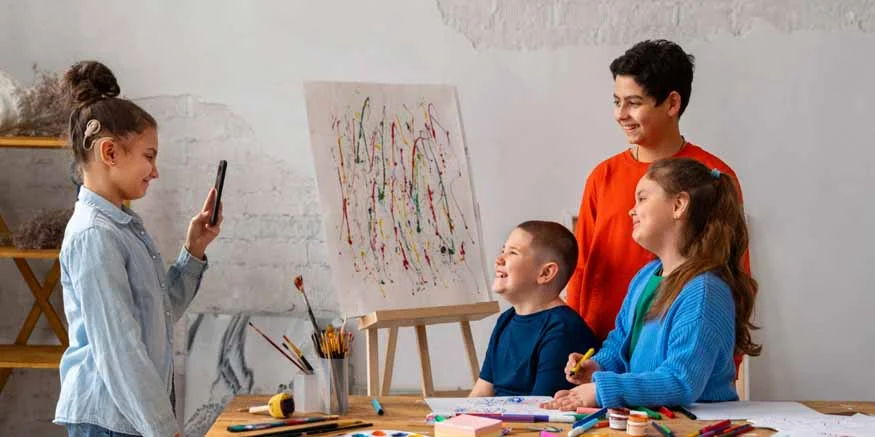Creativity is often perceived as an innate talent, yet it can be cultivated through purposeful effort. Nurturing creativity involves establishing environments that stimulate imagination, encourage experimentation, and support diverse expressions of creativity. This blog explores how fostering creativity can unlock human potential.
How to Nurture Creativity: Practical Tips and Strategies
Cultivating creativity doesn’t require an elaborate plan; sometimes, even minor adjustments can have a profound impact. Creativity can be fostered in various settings—be it at home, in the workplace, or within personal projects—through open-ended questions, embracing failure as a learning opportunity, and encouraging varied experiences. Here are practical strategies for encouraging creative thinking.
Practical Tips and Strategies for Fostering Creativity
Encouraging a Growth Mindset
Strategy: Create an environment where mistakes are viewed as learning opportunities rather than failures. Highlight the importance of effort, perseverance, and continuous improvement. When individuals believe in the potential to develop their abilities through effort, they’re more inclined to take creative risks and try new ideas.
Implementation: Praise effort rather than innate talent, and openly discuss the learning process. Encourage students to reflect on lessons learned from challenges and how they can apply these insights to future projects.
Providing Diverse Experiences
Strategy: Exposure to a wide range of activities, subjects, and environments stimulates creativity by introducing new perspectives. Whether through travel, reading, art, science, or hands-on projects, varied experiences broaden the mind and inspire original thinking.
Implementation: Integrate exhibitions, guest speakers, or interdisciplinary projects in the classroom. At home, expose children to different cultures, hobbies, and art forms. Encourage exploring subjects beyond their usual interests.
Promoting Collaboration and Teamwork
Strategy: Collaboration allows individuals to exchange ideas, combining their unique perspectives to create something new. Working in teams enhances problem-solving skills and leads to innovative solutions that may not emerge in isolation.
Implementation: Organize group activities where students brainstorm and work on creative projects. Encourage open dialogue and respect for diverse viewpoints. Tools like brainstorming sessions, peer reviews, and group challenges can facilitate collaborative creativity.
Creating a Safe Space for Risk-Taking
Strategy: Creativity often involves risk-taking, experimentation, and facing potential failure. Establish a safe environment where people feel free to experiment without fear of judgment.
Implementation: Set ground rules for respect and positive feedback. Encourage sharing ideas, even unconventional ones, and celebrate creative thinking regardless of the outcome. Allow room for trial and error in assignments and projects.
Incorporating Play and Unstructured Time
Strategy: Play is a powerful tool for fostering creativity, as it allows the mind to explore and connect ideas in new ways. Unstructured time gives individuals the freedom to engage in imaginative play, follow interests, and think creatively without constraints.
Implementation: Dedicate time for free play or creative exploration in the classroom or at home. Provide materials like art supplies, building blocks, or musical instruments, and let individuals create without specific instructions. Encourage imaginative activities like storytelling or role-playing games.
Also Read- Project-Based Learning In Classroom: Meaning And Strategies
Nurturing Creativity in Education: Integrating Across the Curriculum
Creativity shouldn’t be confined to art classes; it’s essential in all subjects. Here’s how educators can integrate creativity across the curriculum—from STEM to the humanities—leading to a deeper understanding and more engaged, motivated students.
Real Classroom Activities to Foster Creativity
- Group Storytelling: A teacher begins a story, and each student adds to it, encouraging teamwork and inclusivity with no “right” or “wrong” answers.
- Interactive Role-Playing: Students assume characters from a historical event or novel, promoting engagement and allowing kinaesthetic and auditory learners to participate fully.
- Classroom Makerspace: Provide materials like clay, electronics, or art supplies for hands-on problem-solving, ideal for diverse learning needs.
- Math “Escape Room” Challenge: Mixed-ability groups work on curriculum-based puzzles, fostering collaborative problem-solving.
- Cultural Day Presentations: Students research and present a culture, celebrating diversity and accommodating different learning styles.









